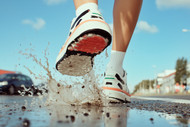Running with Science, Math and Technology
Posted by TRX Books on 2025 May 9th

I love running, and I hate running. It gives me joy. And it gives me pain. Sometimes a lot of it, over a long time. In my years as a young boy, my body was stronger, and running was my happy moment. We had a very small home in an urban concrete jungle, so running at school was one of my favorite pastimes. I had so much fun playing tag or just playing soccer with friends. As I grew older, injuries connected to running started showing up at the party. Starts with small blisters, then graduates into leg aches and cramps. Like everything in life, age catches up and leaves its marks.
As much as I love running, I also love Science, Math, and Technology. For this essay, I decided to look for connections with these three disciplines and running. Were there even some facts from my hobby? What kinds of Math can we use with this very physical activity? And can technology play a role in keeping me running?
Here are three awesome things I found about Running. First, what does Science tell us?
Medical science concludes that running and training for a half marathon actually upgrades your body. Scientific evidence indicates that as you train your body with regular endurance exercises, two important things happen: (a) you improve your heart function by “increasing the size and efficiency of the left ventricle” (the chamber that pumps oxygen-rich blood to your body) [1]; and (b) significantly improve your cardiovascular health and increase your VO2 max [2].
When you train for a half marathon, your heart gets a workout as well, just like your legs. In time, the heart adapts and becomes more efficient in pumping blood, which delivers more oxygen to all your muscles, improving the body’s fitness. It's like you just upgraded your heart from a sedan to a super sports car. A stronger heart means you can run longer with less fatigue, recover faster, and even lower your resting heart rate (a sign of good cardiovascular health). So, every mile you log isn’t just building endurance—it’s literally reshaping your heart (and your body) for the better.
While training for a half marathon, you’re also doing a lot of running over several weeks or months. This consistent, long-distance running is a type of endurance training. Your heart and lungs get a serious workout during this process. The term “VO2 max” is a fancy term that measures the “maximum amount of oxygen your body can use during intense exercise.” When you improve your VO2 max, you’re essentially making your heart stronger and more efficient at pumping blood and delivering oxygen to your muscles.
As you train, your heart becomes better at pumping blood with each beat—— meaning it doesn’t have to work as hard to supply your body with oxygen. This makes you less likely to get tired quickly and improves your overall endurance. Additionally, stronger cardiovascular health reduces the risk of heart disease, lowers blood pressure, and improves your body's ability to recover after exercise.
In summary, when we lace up those shoes and hit the pavement for our half-marathon training, we're not just preparing to run 13.1 miles… we're also giving our heart and lungs a serious upgrade, making us healthier and more fit overall. Maybe running *is* the fountain of youth?
Now let's turn to Math - how could math possibly be used in running other than counting kilometers? There are two interesting areas I have discovered: Math in determining heart zones, and prediction/modeling race times.
Effective training often involves targeting specific heart rate zones, which are calculated as percentages of your maximum ‘heart rate’ (Max HR ≈ 220 - Age). For example, 'Zone 2' (aerobic base building) is typically 60-70% of Max HR. I just learned about the Karvonen formula, which is expressed as:
Target Heart Rate = ((Max HR - Resting HR) * %Intensity) + Resting HR
This provides a more personalized calculation of what we can aim for as runners. Training becomes a data-driven process of accumulating time in specific, mathematically defined “intensity levels” to deliver optimal physiological responses.
In forecasting race times, we can mathematically estimate (forecast) your potential half marathon time by using a model based on shorter race performances: Riegel's formula is expressed as:
T₂ = T₁ * (D₂/D₁) ^1.06
where T₁ is your time for distance D₁ (your time for the 5k distance); T₂ is the predicted time for distance D₂ (your 21km half marathon distance); and 1.06 is an empirically derived exponent accounting for fatigue.
Plugging in your 5k or 10k time allows you to generate a data-based initial goal for the 21.1km distance, which becomes a predictable (though not perfect) relationship between performance across different endurance challenges. Remember, everyone is different, conditions and circumstances change, and that's why we say this is more of an estimated formula. Use it as motivation to get stronger!
After discussing all those formulas and data points, how can we possibly supply those numbers to use those formulas? This is where the last discipline comes in handy: Technology helps runners with data points and indicators. Technology completes the math in running. Technology also makes running more accessible, enjoyable, and effective for all runners. I want to focus on using our personal performance as data, and in turn using the data to uncover performance insights..
Running with smart watches connected to apps on the smartphone provides us with personalized information: from our resting heart rate, to our running pace, time, and distance covered via GPS. When we track these various data points, we have the inputs needed for the two mathematical formulas above.
For determining running pace and forecasting race times without a smart watch, we go old school and just use a simple digital watch for time, and mark distance via Google Maps. Activate your watch’s timer, and mark your time when you hit your first 5k or 10k, based on what we mark on a Google Map as the first 5k or 10k. Then, turn to the web and find an online “pace calculator” that will give you an approximation of your race time.
Think of the data collection of our run’s performance like a car's engine output. It's a far more accurate reflection of our effort than just speed, especially on hilly courses or when we experience headwinds or even worse, hills and inclines. Technology allows us to train smarter, not just harder, and understand our full potential on race day.
The world of running is a fun and difficult endeavor. Thanks to Science, Math and Technology, we get to plan, analyze, and dive deeper into every run we enjoy. Not only are we invigorated with it, we also get to understand areas that show us what is possible for future runs. This, for me, makes every effort and analysis worth it. See you out there!
Sources:
1. Möhlenkamp et al., *JACC* (2014)
(https://www.sciencedirect.com/science/article/pii/S0735109713059030
2. "Effects of Endurance Training on Maximal Oxygen Uptake and Cardiovascular Function" Journal of Sports Science & Medicine, 2013;12:530-538. Link: https://www.jssm.org/jssm-12-530.pdf
